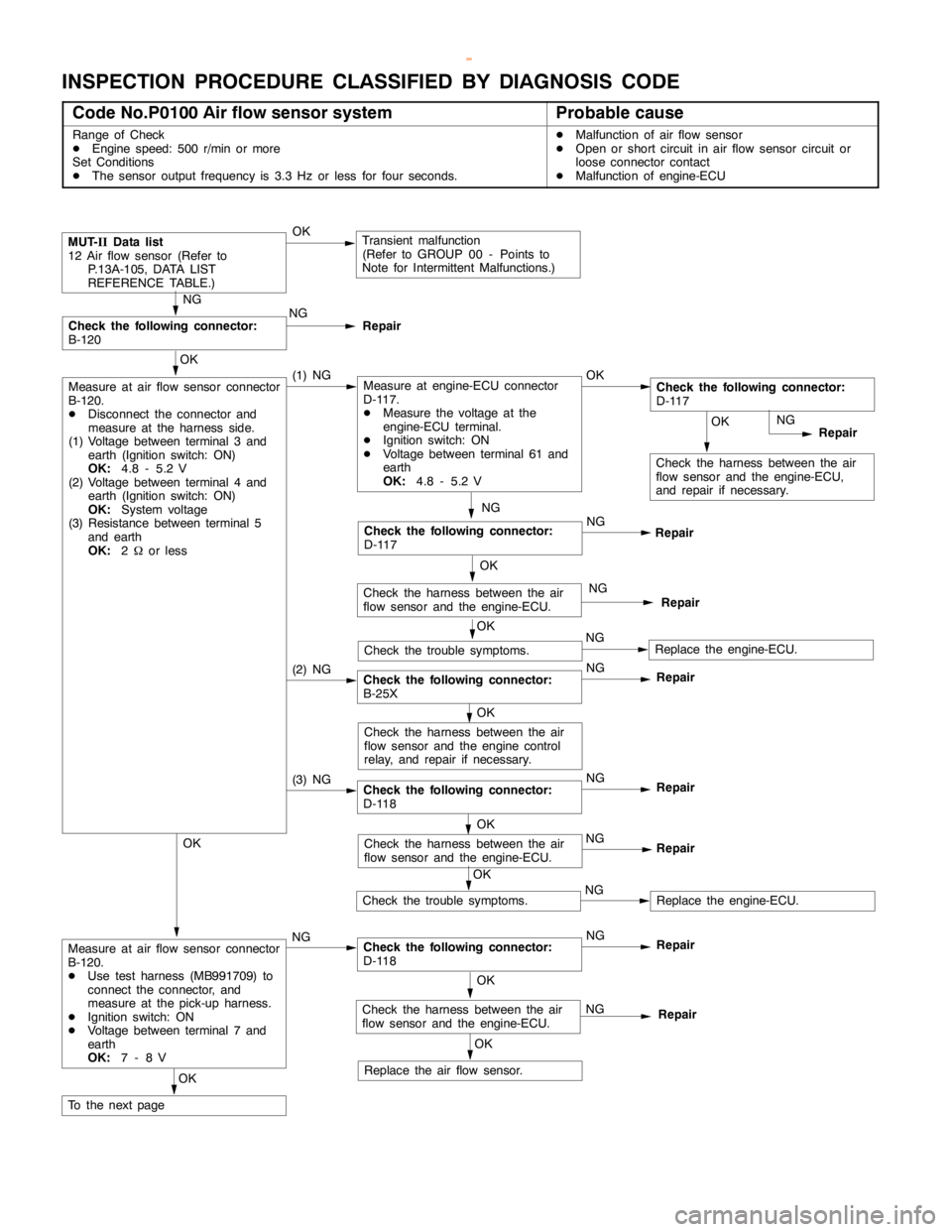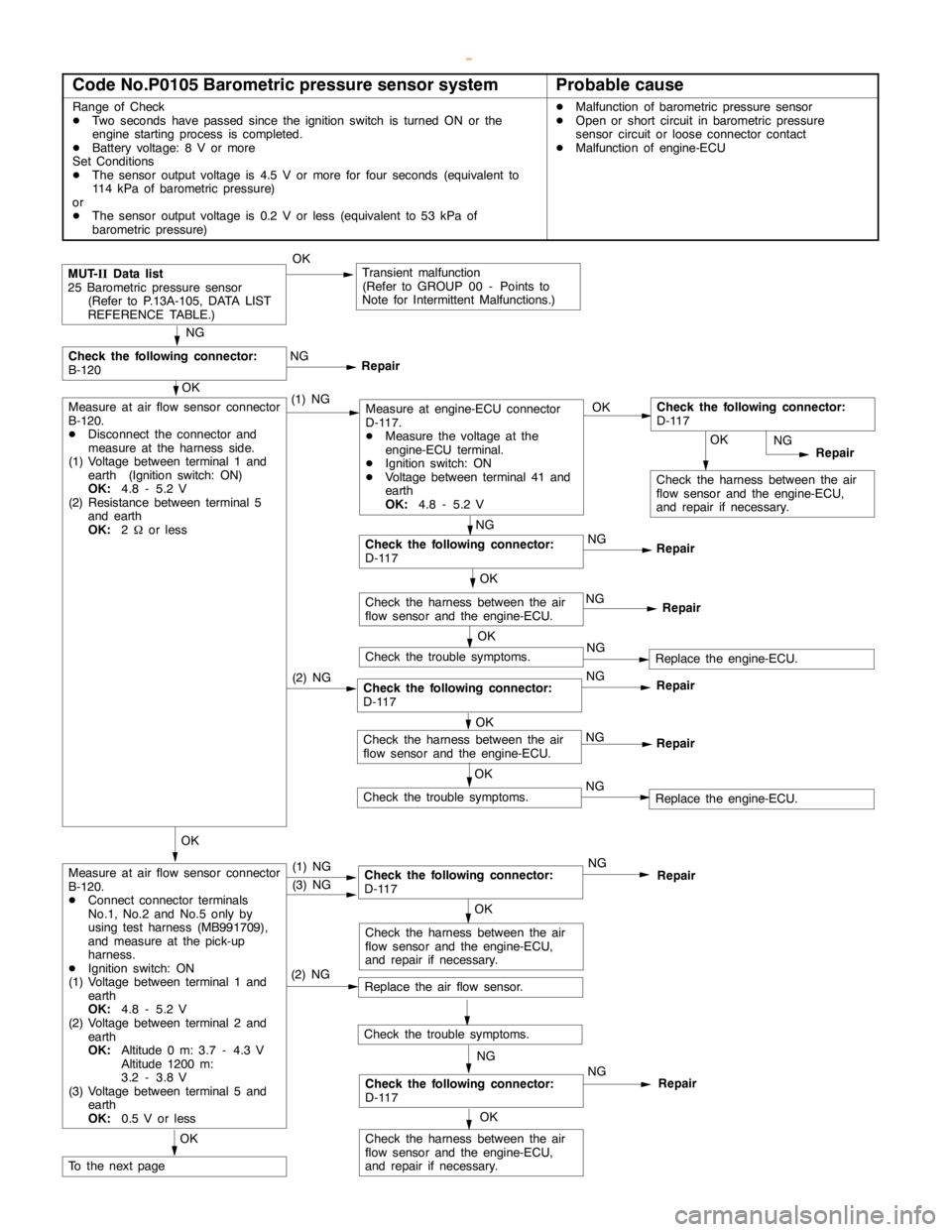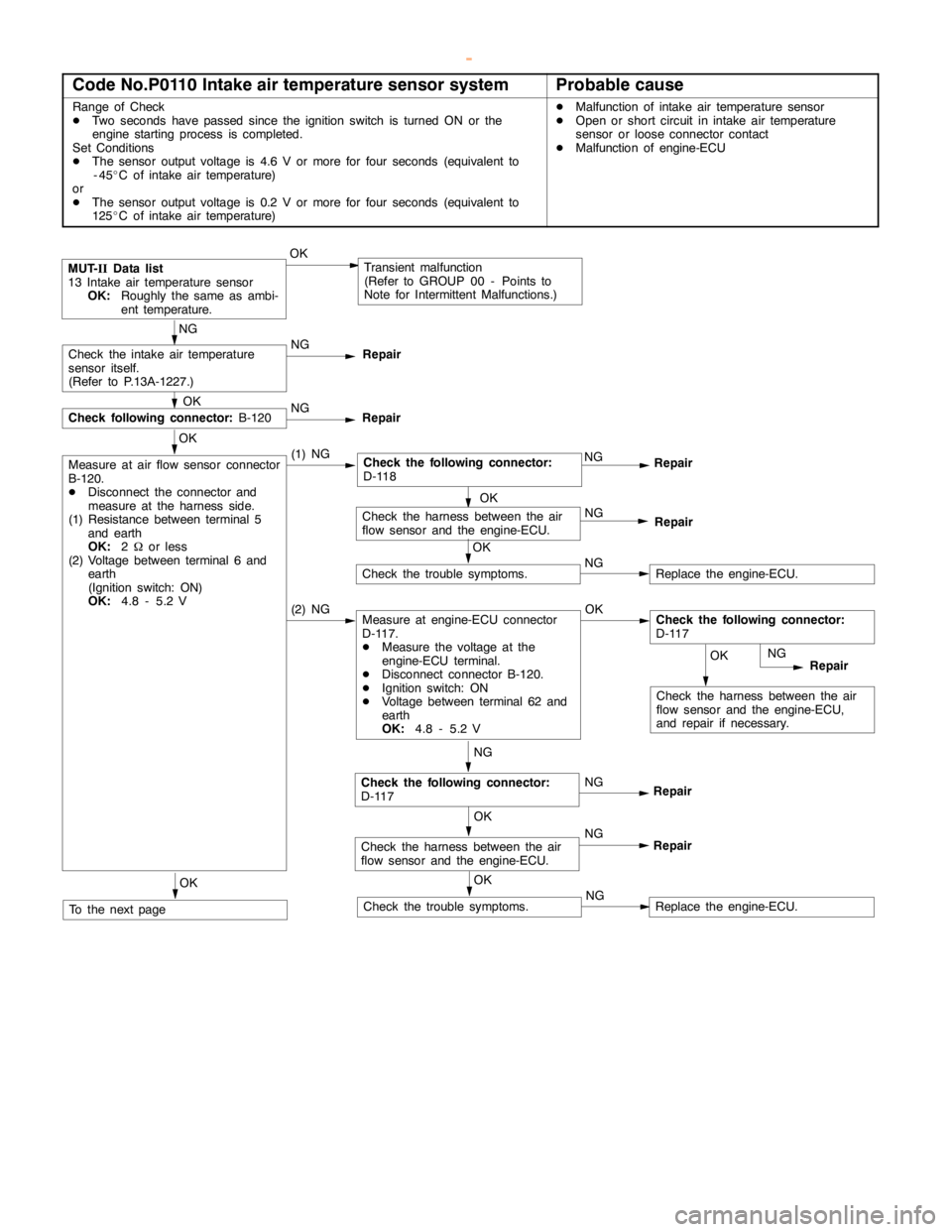2000 MITSUBISHI MONTERO air condition
[x] Cancel search: air conditionPage 4 of 1839

GENERAL -How to Use This Manual00-3
MODEL INDICATIONS
The following abbreviations are used in this manual for classification of model types.
GDI: Indicates the gasoline direct injection.
DOHC: Indicates an engine with the double overhead camshaft, or models equipped with such an
engine.
M/T: Indicates the manual transmission, or models equipped with the manual transmission.
A/T: Indicates the automatic transmission, or models equipped with the automatic transmission.
A/C: Indicates the air conditioner.
www.WorkshopManuals.co.uk
Purchased from www.WorkshopManuals.co.uk
Page 11 of 1839

GENERAL -How to Use Troubleshooting/Inspection Service Points00-10
HOW TO USE THE INSPECTION PROCEDURES
The causes of a high frequency of problems occurring in electronic circuitry are generally the connectors,
components, the ECU and the harnesses between connectors, in that order. These inspection procedures
follow this order, and they first try to discover a problem with a connector or a defective component.
D
Indicator does not turn on or off even if control
mode switch is pressed.
D
Indicator switch should not be illuminated is
illuminated.Probable cause
OK
OK
OK
Measure at switch connector A-44
DDisconnect the connector, and measure at the harness
side.
DVoltage between terminal 6 - earth and terminal 8 -
earth
OK:Approx. 5V
OK
NG
Check the following connector.A-44
Repair
OK
Check trouble symptom.
Replace the ECS-ECU.
In the above cases, the ECS switch circuit is defective or the indicator
circuit is defective.
CHECKING PROCEDURE 4
2. Indicates inspection carried out using the
MUT-
II.
Indicates the operation and inspection proce-
dures.
Indicates the OK judgement conditions.
3. Detailed inspection procedures (methods)
such as component inspection andcircuit
inspection are listed on a separate page, and
are given here for reference.
5. Inspect the contact condition at each connectorterminal.
(Refer to Connector Inspection Service Points.)
The connector position can be located in the wiring diagram in the
electrical wiring manual bymeans ofthis symbol.
Caution
After carrying out connector inspection, always be sure to
reconnect the connector as it was before.
6. Confirm that there are trouble symptoms. If trouble symptomshave
disappeared, the connector may have been inserted incorrectly and the
trouble symptom mayhave disappeared during inspection.
If it seemsthat trouble symptoms still remain, proceed to the nextpage of
instructions.
7. If trouble symptoms still remain up to this stage, there is a possibility that there is an
open orshort circuit in the harness between the connectors, socheck the harness.
Alternatively, the cause may be a defectiveECU, so try replacing the ECU andcheck
if the trouble symptom disappears.
NGECU switch component inspection (Refer to P.33-44.)
NG
1. Comments on the diagnosis code ortrouble
symptom above.
MUT-II
Data list
17 Control mode selectionswitch
OK:Voltage changes between approx. 0V
®approx.
2.5V
®approx. 5V when the switch is operated.
4. Indicates voltage and resistance to be measured at a particular
connector.
(Refer to Connector Measurement Service Points.)
The connector position can be located in the wiring diagram in the
electrical wiring manual bymeans ofthis symbol.
Indicates operation and inspection procedures, inspection terminals
and inspection conditions.
Indicates the OK judgement conditions.
HARNESS INSPECTION
Check for an open or short circuit in the harness between the terminals which were defective according
to the connector measurements. Carry out this inspection while referring to the electrical wiring manual.
Here, “Check harness between power supply and terminal xx” also includes checking for blown fuses.
For inspection service points when there is a blown fuse, refer to “Inspection Service Points for a Blown
Fuse.”
MEASURES TO TAKE AFTER REPLACING THE ECU
If the trouble symptoms have not disappeared even after replacing the ECU, repeat the inspection procedure
from the beginning.
www.WorkshopManuals.co.uk
Purchased from www.WorkshopManuals.co.uk
Page 46 of 1839

3 MSB-00E00-505
3. Details:
Contents of Attachment are to be added to GROUP 00 (GENERAL).
PRECAUTIONS BEFORE SERVICE
LEARNING FUNCTION OF GDI ENGINE
1. Purpose
On the GDI engine equipped cars, when replacement of the ECU (for engine control) or resetting
of the battery* has been performed, an idle learning function of the ECU (for engine control) will
be required.
The idle learning function will be completed by running the engine at idle by the following procedure.
NOTE:
*: Disconnection of ECU (for engine control) battery backup power supply (disconnection of battery
terminals or ECU connectors)
2. Idle Learning Procedure
(1) Start the engine, and warm up the engine until its coolant temperature reaches 85°C or higher.
When the engine coolant temperature is 85°C or higher, you have only to turn the ignition
switch to the ON position.
(2) Turn the ignition switch to the LOCK (OFF) position, and stop the engine.
(3) After lapse of ten or more seconds, restart the engine.
(4) Run the engine at idle for ten minutes under the following conditions.
DTransmission: Neutral (P range for automatic transmission)
DAir conditioner and heater: Not operational
DEngine coolant temperature: 83°C or higher
(5) Stop the engine.
(6) Restart the engine, and run it at idle for ten minutes under the following condition.
DTransmission: Neutral (P range for automatic transmission)
DAir conditioner: Operational (Temperature set at “maximum cool”, fan at high speed, and
windows fully opened)
DEngine coolant temperature: 83°C or higher
(7) Repeat steps (5) and (6).
NOTE:
1) When the atmospheric temperature is 20°C or more and the air conditioner has continuously
been operated, step (7) may be omitted.
2) During idling operation of the engine in steps (4) and (6), when engine operation switches
from lean operation to stoichiometric operation, engine stall can occur. In this case, clean the
throttle body (throttle valve) thoroughly, and then repeat step (1) and the subsequent steps.
www.WorkshopManuals.co.uk
Purchased from www.WorkshopManuals.co.uk
Page 217 of 1839

GDI -General Information13A-3
GENERAL INFORMATION
The Gasoline Direct Injection System consists
of sensors which detect the engine conditions,
the engine-ECU
which controls the system based on
signals from these sensors, and actuators
which operate under the control of the
engine-ECU
carries out activities such as fuel injection
control, idle speed control and ignition timing
control. In addition, the engine-ECU
engine-A/T-ECU is equipped with several
diagnosis modes which simplify troubleshooting
when a problem develops.
FUEL INJECTION CONTROL
The injector drive times and injector timing are
controlled so that the optimum air/fuel mixture
is supplied to the engine to correspond to the
continually-changing engine operation condi-
tions.
A single injector for each cylinder is mounted
at the cylinder head. The fuel is sent under
pressure from the fuel tank to the fuel pressure
regulator (low pressure) by the fuel pump (low
pressure). The pressure is regulated by the
fuel pressure regulator (low pressure) and the
fuel regulated is then sent to the fuel pump
(high pressure). The fuel under increased
pressure generated by the fuel pump (high
pressure) is then regulated by the fuel pressure
regulator (high pressure) and is then distributed
to each of the injectors via the delivery pipes.Fuel injection is normally carried out once for
each cylinder for every two rotations of the
crankshaft. The firing order is 1-2-3-4-5-6. This
is called sequential fuel injection.
When the engine is cold or under a severe
load, the “open-loop” control keeps the air/fuel
ratio at a richer than usual level to maintain
driveability. When the engine is under low or
medium loads, the air/fuel ratio becomes leaner
to reduce fuel consumption. When the engine
is running at medium or high loads after having
warmed up, the “closed-loop” control uses the
signal from the oxygen sensor to keep the
air/fuel ratio at the optimum theoretical level.
THROTTLE VALVE OPENING ANGLE CONTROL
This system controls throttle valve opening
angle electronically. The engine-ECU
or engine-A/T-ECU determines how
deeply the accelerator pedal is depressed by
means of the accelerator position sensor (APS).
Then the engine-ECU
throttle valve opening angle to the throttle valve
controller. The throttle valve control servo
operates the throttle valve so that it reaches
the target opening angle.
IDLE SPEED CONTROL
This system maintains engine idle speed at
a predetermined condition by controlling the
air flow that passes through the throttle valve
according to engine idling condition and engine
loads at idling.
The engine-ECU
operates the throttle valve control servoso that engine speed is maintained within a
map value. The map value is predetermined
according to engine coolant temperature and
air-conditioning load.
IGNITION TIMING CONTROL
The power transistor located in the ignition
primary circuit turns ON and OFF to control
the primary current flow to the ignition coil. This
controls the ignition timing in order to provide
the optimum ignition timing with respect to the
engine operating conditions. The ignition timingis determined by the engine-ECU
engine-A/T-ECU from the engine speed,
intake air volume, engine coolant temperature,
atmospheric pressure and injection timing
(intake stroke or compression stroke).
www.WorkshopManuals.co.uk
Purchased from www.WorkshopManuals.co.uk
Page 227 of 1839

GDI -Troubleshooting
FAIL-SAFE FUNCTION REFERENCE TABLE
When the main sensor malfunctions are detected by the diagnosis function, the vehicle is controlled
by means of the pre-set control logic to maintain safe conditions for driving.
Malfunctioning itemControl contents during malfunction
Air flow sensor1. Suspends lean burn operation.
2. Uses the throttle position sensor signal and engine speed signal (crank angle
sensor signal) to take reading of the basic injector drive time and basic ignition
timing from the pre-set mapping.
Intake air temperature sensorControls as if the intake air temperature is 25_
C.
Throttle position sensor (2nd
channel)1. Suspends lean burn operation.
2. Controls the throttle opening angle feedback (half as much as the opening
rate in the normal condition) by using signals from the throttle position sensor
(1st channel). However, this controlling system is not applied if the throttle
position sensor (1st channel) and throttle position sensor (2nd channel)
combination output voltage is outside 4 - 6 V.
3. Refrains from controlling the throttle opening angle feedback if the throttle
position sensor (1st channel) is also defective.
Engine coolant temperature
sensorControls as if the engine coolant temperature is 80_
C. (Moreover, the control system
is working until the ignition switch is turned OFF if the sensor signal returns to normal.)
Camshaft position sensorCuts the fuel supply once a malfunction is detected. (Only when there has been
no occasion of detecting No.1 cylinder top dead centre after the ignition switch
is turned ON.)
Vehicle speed sensor1. Suspends lean burn operation. However, the control is cancelled as a certain
time passes by with the engine speed of 1,500 r/min or more.
2. Suspends lean burn operation during the engine idling.
Barometric pressure sensorControls as if the barometric pressure is 101 kPa.
Detonation sensorFixes the ignition timing as that for standard petrol.
Injector1. Suspends lean burn operation.
2. Suspends the exhaust gas recirculation.
Ignition coil (incorporating pow-
er transistor)1. Suspends lean burn operation.
2. Cuts off the fuel supply to cylinders with an abnormal ignition signal.
Fuel pressure sensor1. Controls as if the fuel pressure is 5MPa.
2
. Suspends fuel injection. (when the low pressure is detected and the engine
speed is more than 3,000r/min)
Alternator FR terminalRefrains from controlling to suppress the alternator output to electrical load.
(Operated as a normal alternator)
Accelerator pedal position sen-
sor (2nd channel)1. Suspends lean burn operation.
2. Controls the throttle valve position by using signals from the accelerator pedal
position sensor (1st channel). (However, the control system is not applicable
if the difference from the accelerator pedal position sensor (1st channel) output
voltage is 1.0 V or higher.)
3
. Suspends the electronic controlled throttle valve system if accelerator pedal
position sensor (1st channel) is also defective.
www.WorkshopManuals.co.uk
Purchased from www.WorkshopManuals.co.uk
Page 231 of 1839

GDI -Troubleshooting
INSPECTION PROCEDURE CLASSIFIED BY DIAGNOSIS CODE
Code No.P0100 Air flow sensor systemProbable cause
Range of Check
DEngine speed: 500 r/min or more
Set Conditions
DThe sensor output frequency is 3.3 Hz or less for four seconds.DMalfunction of air flow sensor
DOpen or short circuit in air flow sensor circuit or
loose connector contact
DMalfunction of engine-ECU
(3) NGCheck the following connector:
D-118NG
Repair
(2) NGCheck the following connector:
B-25XNG
Repair
OK
Check the harness between the air
flow sensor and the engine-ECU,
and repair if necessary.
MUT-
IIData list
12 Air flow sensor (Refer to
P.13A-105, DATA LIST
REFERENCE TABLE.)OKTransient malfunction
(Refer to GROUP 00 - Points to
Note for Intermittent Malfunctions.)
NG
Check the following connector:
B-120NG
Repair
OK
Measure at air flow sensor connector
B-120.
DDisconnect the connector and
measure at the harness side.
(1) Voltage between terminal 3 and
earth (Ignition switch: ON)
OK:
4.8 - 5.2 V
(2) Voltage between terminal 4 and
earth (Ignition switch: ON)
OK:
System voltage
(3) Resistance between terminal 5
and earth
OK:
2Wor less(1) NGMeasure at engine-ECU connector
D-117.
DMeasure the voltage at the
engine-ECU terminal.
DIgnition switch: ON
DVoltage between terminal 61 and
earth
OK:
4.8 - 5.2 VOKCheck the following connector:
D-117
NG
Repair
OK
Replace the air flow sensor.
NG
Check the following connector:
D-117NG
Repair
OK
Check the harness between the air
flow sensor and the engine-ECU.NG
Repair
OK
Check the trouble symptoms.NGReplace the engine-ECU.
OK
Check the harness between the air
flow sensor and theengine control
relay, and repair if necessary.
OK
Check the harness between the air
flow sensor and the engine-ECU.NG
Repair
OK
Check the trouble symptoms.NGReplace the engine-ECU.
OK
Measure at air flow sensor connector
B-120.
DUse test harness (MB991709) to
connect the connector, and
measure at the pick-up harness.
DIgnition switch: ON
DVoltage between terminal 7 and
earth
OK:
7-8VNGCheck the following connector:
D-118NG
Repair
OK
Check the harness between the air
flow sensor and the engine-ECU.NG
Repair
OK
To the nextpage
www.WorkshopManuals.co.uk
Purchased from www.WorkshopManuals.co.uk
Page 233 of 1839

GDI -Troubleshooting
Code No.P0105 Barometric pressure sensor systemProbable cause
Range of Check
DTwo seconds have passed since the ignition switch is turned ON or the
engine startingprocess is completed.
DBattery voltage: 8 V or more
Set Conditions
DThe sensor output voltage is 4.5 V or more for four seconds (equivalent to
114 kPa of barometric pressure)
or
DThe sensor output voltage is 0.2 V or less (equivalent to 53 kPa of
barometric pressure)DMalfunction of barometric pressure sensor
DOpen or short circuit in barometric pressure
sensor circuit or loose connector contact
DMalfunction of engine-ECU
(2) NGCheck the following connector:
D-117NG
Repair
OK
Check the harness between the air
flow sensor and the engine-ECU,
and repair if necessary.
MUT-
IIData list
25 Barometric pressure sensor
(Refer to P.13A-105, DATA LIST
REFERENCE TABLE.)OKTransient malfunction
(Refer to GROUP 00 - Points to
Note for Intermittent Malfunctions.)
NG
NG
Repair
OK
Measure at air flow sensor connector
B-120.
DDisconnect the connector and
measure at the harness side.
(1) Voltage between terminal 1 and
earth (Ignition switch: ON)
OK:
4.8 - 5.2 V
(2) Resistance between terminal 5
and earth
OK:
2Wor less(1) NGMeasure at engine-ECU connector
D-117.
DMeasure the voltage at the
engine-ECU terminal.
DIgnition switch: ON
DVoltage between terminal 41 and
earth
OK:
4.8 - 5.2 VOKCheck the following connector:
D-117
NG
Repair
NG
Check the following connector:
D-117NG
Repair
OK
Check the harness between the air
flow sensor and the engine-ECU.NG
Repair
OK
Check the trouble symptoms.NGReplace the engine-ECU.
OK
Measure at air flow sensor connector
B-120.
DConnect connector terminals
No.1, No.2 and No.5 only by
using test harness (MB991709),
and measure at the pick-up
harness.
DIgnition switch: ON
(1) Voltage between terminal 1 and
earth
OK:
4.8 - 5.2 V
(2) Voltage between terminal 2 and
earth
OK:
Altitude 0 m: 3.7 - 4.3 V
Altitude 1200 m:
3.2 - 3.8 V
(3) Voltage between terminal 5 and
earth
OK:
0.5 V or less(1) NGCheck the following connector:
D-117NG
Repair
OK
Check the harness between the air
flow sensor and the engine-ECU,
and repair if necessary.
OK
To the nextpage(3) NG
(2) NG
Replace the air flow sensor.
NG
Check the following connector:
D-117NG
Repair
OK
Check the harness between the air
flow sensor and the engine-ECU,
and repair if necessary.
OK
Check the harness between the air
flow sensor and the engine-ECU.NG
Repair
OK
Check the trouble symptoms.NGReplace the engine-ECU.
Check the following connector:
B-120
Check the trouble symptoms.
www.WorkshopManuals.co.uk
Purchased from www.WorkshopManuals.co.uk
Page 235 of 1839

GDI -Troubleshooting
Code No.P0110 Intake air temperature sensor systemProbable cause
Range of Check
DTwo seconds have passed since the ignition switch is turned ON or the
engine startingprocess is completed.
Set Conditions
DThe sensor output voltage is 4.6 V or more for four seconds (equivalent to
-45_C of intake air temperature)
or
DThe sensor output voltage is 0.2 V or more for four seconds (equivalent to
125_C of intake air temperature)DMalfunction of intake air temperature sensor
DOpen or short circuit in intake air temperature
sensor or loose connector contact
DMalfunction of engine-ECU
OK
Check the harness between the air
flow sensor and the engine-ECU,
and repair if necessary.
MUT-
IIData list
13 Intake air temperature sensor
OK:
Roughly the same as ambi-
ent temperature.OKTransient malfunction
(Refer to GROUP 00 - Points to
Note for Intermittent Malfunctions.)
NG
Check the intake air temperature
sensor itself.
(Refer to P.13A-1227.)NG
Repair
OK
Measure at air flow sensor connector
B-120.
DDisconnect the connector and
measure at the harness side.
(1) Resistance between terminal 5
and earth
OK:
2Wor less
(2) Voltage between terminal 6 and
earth
(Ignition switch: ON)
OK:
4.8 - 5.2 V(1) NG
NGRepair
NG
Repair
NG
Check the following connector:
D-117NG
Repair
OK
Check the harness between the air
flow sensor and the engine-ECU.NG
Repair
OK
Check the trouble symptoms.NGReplace the engine-ECU.
OK
Check following connector:
B-120NG
Repair
(2) NGMeasure at engine-ECU connector
D-117.
DMeasure the voltage at the
engine-ECU terminal.
DDisconnect connector B-120.
DIgnition switch: ON
DVoltage between terminal 62 and
earth
OK:
4.8 - 5.2 VOKCheck the following connector:
D-117
OK
Check the harness between the air
flow sensor and the engine-ECU.NG
Repair
OK
Check the trouble symptoms.NGReplace the engine-ECU.
OK
To the nextpage
Check the following connector:
D-118
www.WorkshopManuals.co.uk
Purchased from www.WorkshopManuals.co.uk